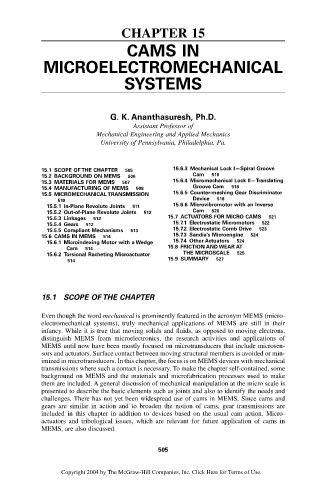Page 517 - Cam Design Handbook
P. 517
THB15 9/19/03 8:03 PM Page 505
CHAPTER 15
CAMS IN
MICROELECTROMECHANICAL
SYSTEMS
G. K. Ananthasuresh, Ph.D.
Assistant Professor of
Mechanical Engineering and Applied Mechanics
University of Pennsylvania, Philadelphia, Pa.
15.1 SCOPE OF THE CHAPTER 505 15.6.3 Mechanical Lock I—Spiral Groove
15.2 BACKGROUND ON MEMS 506 Cam 516
15.3 MATERIALS FOR MEMS 507 15.6.4 Micromechanical Lock II—Translating
15.4 MANUFACTURING OF MEMS 508 Groove Cam 518
15.5 MICROMECHANICAL TRANSMISSION 15.6.5 Counter-meshing Gear Discriminator
510 Device 518
15.5.1 In-Plane Revolute Joints 511 15.6.6 Microvibromotor with an Inverse
15.5.2 Out-of-Plane Revolute Joints 512 Cam 520
15.5.3 Linkages 512 15.7 ACTUATORS FOR MICRO CAMS 521
15.5.4 Gears 512 15.7.1 Electrostatic Micromotors 522
15.5.5 Compliant Mechanisms 513 15.7.2 Electrostatic Comb Drive 523
15.6 CAMS IN MEMS 514 15.7.3 Sandia’s Microengine 524
15.6.1 Microindexing Motor with a Wedge 15.7.4 Other Actuators 524
Cam 514 15.8 FRICTION AND WEAR AT
15.6.2 Torsional Racheting Microactuator THE MICROSCALE 525
15.9 SUMMARY 527
514
15.1 SCOPE OF THE CHAPTER
Even though the word mechanical is prominently featured in the acronym MEMS (micro-
electromechanical systems), truly mechanical applications of MEMS are still in their
infancy. While it is true that moving solids and fluids, as opposed to moving electrons,
distinguish MEMS from microelectronics, the research activities and applications of
MEMS until now have been mostly focused on microtransducers that include microsen-
sors and actuators. Surface contact between moving structural members is avoided or min-
imized in microtransducers. In this chapter, the focus is on MEMS devices with mechanical
transmissions where such a contact is necessary. To make the chapter self-contained, some
background on MEMS and the materials and microfabrication processes used to make
them are included. A general discussion of mechanical manipulation at the micro scale is
presented to describe the basic elements such as joints and also to identify the needs and
challenges. There has not yet been widespread use of cams in MEMS. Since cams and
gears are similar in action and to broaden the notion of cams, gear transmissions are
included in this chapter in addition to devices based on the usual cam action. Micro-
actuators and tribological issues, which are relevant for future application of cams in
MEMS, are also discussed.
505
Copyright 2004 by The McGraw-Hill Companies, Inc. Click Here for Terms of Use.

